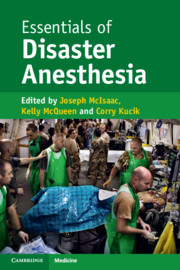Book contents
- Essentials of Disaster Anesthesia
- Essentials of Disaster Anesthesia
- Copyright page
- Contents
- Contributors
- Preface
- Disclaimer
- Chapter 1 Disaster Anesthesia
- Chapter 2 Preparing to Deploy to a Remote Disaster
- Chapter 3 Principles of Emergency and Trauma Surgery
- Chapter 4 Total Intravenous Anesthesia in Disaster Medicine
- Chapter 5 Inhaled Anesthetics and Draw-Over Devices in Disaster Response
- Chapter 6 Airway Management
- Chapter 7 Vascular Access, Hydration, and Fluids
- Chapter 8 Critical Care Delivery for Disasters in Austere Environments
- Chapter 9 Children in Disasters
- Chapter 10 Special Populations: Children
- Chapter 11 Laboratory Tests and Blood Banking
- Chapter 12 High-Altitude Physiology and Anesthesia
- Chapter 13 Disaster: Mental Health Effects, Responses, and What Clinicians Can Do
- Chapter 14 Considerations When Working with Children and Families
- Chapter 15 Chemical and Radiologic Exposures in Trauma and Disasters
- Chapter 16 Pain in Disasters
- Chapter 17 Radiology in the Austere or Disaster Environment
- Chapter 18 Communications
- Chapter 19 Security in Disaster Anesthesia
- Chapter 20 International Humanitarian Law
- Chapter 21 Operation Tomodachi: Anesthetic Implications
- Chapter 22 Austere Obstetric Anesthesia
- Chapter 23 Pharmacy in Disaster Anesthesia
- Chapter 24 Regional Anesthesia in Disaster Circumstances
- Chapter 25 Power and Light: Impact of Electrical Systems Failure on the Delivery of Anesthetic Care
- Book part
- Index
- References
Chapter 10 - Special Populations: Children
Published online by Cambridge University Press: 23 June 2020
- Essentials of Disaster Anesthesia
- Essentials of Disaster Anesthesia
- Copyright page
- Contents
- Contributors
- Preface
- Disclaimer
- Chapter 1 Disaster Anesthesia
- Chapter 2 Preparing to Deploy to a Remote Disaster
- Chapter 3 Principles of Emergency and Trauma Surgery
- Chapter 4 Total Intravenous Anesthesia in Disaster Medicine
- Chapter 5 Inhaled Anesthetics and Draw-Over Devices in Disaster Response
- Chapter 6 Airway Management
- Chapter 7 Vascular Access, Hydration, and Fluids
- Chapter 8 Critical Care Delivery for Disasters in Austere Environments
- Chapter 9 Children in Disasters
- Chapter 10 Special Populations: Children
- Chapter 11 Laboratory Tests and Blood Banking
- Chapter 12 High-Altitude Physiology and Anesthesia
- Chapter 13 Disaster: Mental Health Effects, Responses, and What Clinicians Can Do
- Chapter 14 Considerations When Working with Children and Families
- Chapter 15 Chemical and Radiologic Exposures in Trauma and Disasters
- Chapter 16 Pain in Disasters
- Chapter 17 Radiology in the Austere or Disaster Environment
- Chapter 18 Communications
- Chapter 19 Security in Disaster Anesthesia
- Chapter 20 International Humanitarian Law
- Chapter 21 Operation Tomodachi: Anesthetic Implications
- Chapter 22 Austere Obstetric Anesthesia
- Chapter 23 Pharmacy in Disaster Anesthesia
- Chapter 24 Regional Anesthesia in Disaster Circumstances
- Chapter 25 Power and Light: Impact of Electrical Systems Failure on the Delivery of Anesthetic Care
- Book part
- Index
- References
Summary
Anesthesiologists are likely to face pediatric disaster victims both in the developed world and in developing countries, as children are a significant percentage of the global population. Although many challenges in taking care of children in disasters, especially in resource-poor countries, are like the ones described elsewhere in this book, pediatric disaster preparedness involves some unique considerations. The following provides a brief overview of essential equipment, training, and resuscitation as applicable to the anesthesiologist caring for a child in a disaster.
- Type
- Chapter
- Information
- Essentials of Disaster Anesthesia , pp. 75 - 95Publisher: Cambridge University PressPrint publication year: 2020

